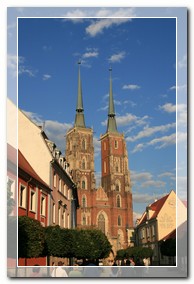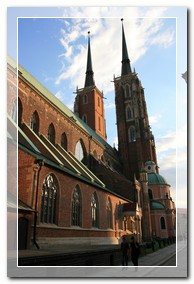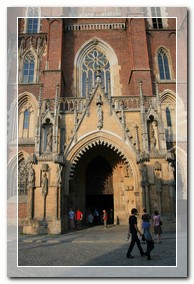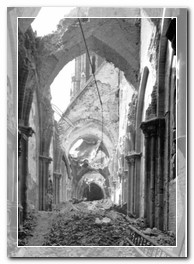


 here is no other place in Wroclaw, that has got so
many beautiful legends, anecdotes and history as the Wroclaw's Cathedral
under the call of saint John Baptist and the surrounding Ostrow Tumski.
There is nothing strange about it, as this cathedral made up the navel
of the former Wroclaw, towering over the low mediaeval buildings of the
city and it was visible in the whole neighborhood.
here is no other place in Wroclaw, that has got so
many beautiful legends, anecdotes and history as the Wroclaw's Cathedral
under the call of saint John Baptist and the surrounding Ostrow Tumski.
There is nothing strange about it, as this cathedral made up the navel
of the former Wroclaw, towering over the low mediaeval buildings of the
city and it was visible in the whole neighborhood.
Such a great undertaking had to last long. The construction of the Cathedral was started in the years 1244–1277, when Bishop Thomas I raised its eastern part. However, four different churches preceded it, built successfully in the same the place. In the moment, in which the oldest part of the Cathedral came into existence, it was the first Gothic temple in Poland. In the XIV century thanks to the famous bishop Nankier the main nave and sacristy were raised. In the XV century the northern tower was built and almost a hundred years later, after the great fire, which took the helmet of the tower, the second one was added from the south. Both were topped with new helmets. Fires digested the cathedral three times later on, however the last one, caused by the explosion of the folded there ammunition under the end of the World War II brought the largest destructions. The cathedral was destroyed in 70% and its reconstruction lasted till the half of the 70's. One can see the pictures of the war destructions on the right from the entrance.
 At present the cathedral
is a triple-naved basilica, which has the length of 100 meters and width
of 44,5 meters. The western elevation is adorned by two beautiful, 100
meter towers. High towers also were supposed to be created from the
east, however they were never finished.
At present the cathedral
is a triple-naved basilica, which has the length of 100 meters and width
of 44,5 meters. The western elevation is adorned by two beautiful, 100
meter towers. High towers also were supposed to be created from the
east, however they were never finished.
The cathedral can be proud of its many valuable works of the art, from which special attention should be paid to the late-gothic triptych of the Holiest Virgin Maria Fallin Asleep, transferred after the war from the evangelical church in Lubin and exquisite XVII century oak ornamented bas-reliefs illustrating the life of saint Norbert , made originally for the Wroclaw's church of saint Wincent on Nankiera square. It contains also a curiosity: the largest organs in Poland, made of the connection of the organs from the Centennial Hall, at the time the largest in the whole world, and the ones from the evangelical church on Sepolno. It has got 150 voices, 5 manuals and 13207 pipes. It is also worth mentioning about the nine chapels, surrounding the cathedral with a wreath. The most beautiful among them are these laid behind the chorus: from south the baroque saint Elisabeth chapel from the years 1682–1700, the gothic Mariacka Chapel from the years 1354–1365, laid on the axis of the cathedral, so on the prolongation of the chorus and this is why it is defined sometimes as the small chorus, and from the north the baroque Elector Chapel, also called God's Body, built in the years 1716–1724.
 The cathedral possesses
three entries: the main entry, from the west, and two side entries, from
the north and south. The main entry to the cathedral leads through the
Gothic portal, decorated with stone sculptures of the Mother of God,
saint Paul and saint Gregory and the figures of patrons of Silesia and
Czech. The scene representing the imprisoned Joseph by his brothers in a
well was placed on the door. The seekers of Wroclaw's legends will be
probably interested more by the stone figures on two entries from both
sides of the cathedral - it is hard to guess, but the first one
represents a lion, while the second one an eagle - two animals that can
be seen in the crest of the city. The legend says, that if a lonely
woman wants to get to know her future beloved, she should touch the
lion, while the lonely man should do the other way round.
The cathedral possesses
three entries: the main entry, from the west, and two side entries, from
the north and south. The main entry to the cathedral leads through the
Gothic portal, decorated with stone sculptures of the Mother of God,
saint Paul and saint Gregory and the figures of patrons of Silesia and
Czech. The scene representing the imprisoned Joseph by his brothers in a
well was placed on the door. The seekers of Wroclaw's legends will be
probably interested more by the stone figures on two entries from both
sides of the cathedral - it is hard to guess, but the first one
represents a lion, while the second one an eagle - two animals that can
be seen in the crest of the city. The legend says, that if a lonely
woman wants to get to know her future beloved, she should touch the
lion, while the lonely man should do the other way round.
A different, quite gloomy legend says that if a cleric while sitting in the Cathedral finds on his chair a white rose, then a certain death awaits him within three days. Supposedly in the XIX century certain a young curate wanting to reverse the bad fate threw the rose on the chair of the oldest canon. This did not help him — in the third day the bells of the cathedral lamented his funeral. Ghostly mourning funeral procession precursory the death of one of the canons traverse also sometimes the main nave of the cathedral in the day of the patron of the chapter, saint Wincent from Saragossy. The witnesses, who swear that they heard the bells, prayers and singings on the ominous day of 22 January, though the church was empty, are still alive. It happens supposedly since the day of the unfortunate death of the lovers - Henry and Maria, who found themselves after years, unfortunately too late. Henry had just received the ordination as a priest . However, tormented by passion he kidnapped Maria from her family house, brought by night to Wroclaw and decided to hide her in his cubby near the sacristy and to look in the morning for help at his uncle, the canon of the Cathedral. However, when the young couple entered the church, they saw a parade of spirits carrying the coffin, in which Henry himself rested. Legs bent under the young man and his heart cracked from fear, while Maria died from despair, seeing him dead at her feet.
Not less gloomy history connects with the head frosen in a mute
shout, which nor in one way or the other protrudes from the wall on the
corner  of the southern tower from the side of the Oder. The
head belonged to a young man from a poor family, who fell in love with
the daughter of a rich banker. Her father obviously threw aside his
tryings, and to soften the refusal, he promised his daughter's hand, if
the young man earns a suitable property. So it happened - several years
after the boy came back to Wroclaw rich. However, the banker found out
that the he gained his properties by robbery and again refused him his
daughter hand. The angry young man in an attack of madness put fire
under the banker's house and then climbed a tower to see his work
better. However punishment reached him: the walls of the tower tightened
around his neck and absorbed him so that the head stood from it only,
with a grimace of horror on his face. This gloomy legend conceals a
different one in itself, already forgotten - heads or pictures of faces
were built in the walls of churches to protect from alive attacking
spirits, nightmares and ghosts. Who was frightened by the "owner" of the
head and why, we do not know today...
of the southern tower from the side of the Oder. The
head belonged to a young man from a poor family, who fell in love with
the daughter of a rich banker. Her father obviously threw aside his
tryings, and to soften the refusal, he promised his daughter's hand, if
the young man earns a suitable property. So it happened - several years
after the boy came back to Wroclaw rich. However, the banker found out
that the he gained his properties by robbery and again refused him his
daughter hand. The angry young man in an attack of madness put fire
under the banker's house and then climbed a tower to see his work
better. However punishment reached him: the walls of the tower tightened
around his neck and absorbed him so that the head stood from it only,
with a grimace of horror on his face. This gloomy legend conceals a
different one in itself, already forgotten - heads or pictures of faces
were built in the walls of churches to protect from alive attacking
spirits, nightmares and ghosts. Who was frightened by the "owner" of the
head and why, we do not know today...
There are however also less gloomy legends connected with the
Wroclaw's cathedral. The most touching is probably the legend about
Maciej, Master Erazm's limping helper and the small sculpture on the
south wall of the Wroclaw's cathedral.  It represents saint Vincent with a breviary
in his left palm and only one leg protruding from under the garment. The
old master Erazm was a famous sculptor in whole Wroclaw and it's
neighborhood. Among his pupils one was particularly clever, but also
devout and gifted with a good heart - Maciej. So what! Other pupils were
pulling his leg, laughing at him, because he was crippled, and had one
leg crooked and shorter than the other. The boy patiently handled the
laughter and nicknames and learnt his profession persistently. In 1470
he was good enough, that the aging master had decided to offer him
sculpturing the statue of saint Vincent, which was bought by the canon
of the cathedral chapter John Paszkowicz. Maciek got down to work. For
four months he carved, improved, polished, until he had finished the
figure of the saint to illusion reminding the real man, clothed in a
habit, from under which two particularly beautifully sculptured legs
stood. "Ah, if I had such legs, I would not have to hear all those
mockings and nicknames!" - Maciek sighed, after what he laid down on his
bed in the corner of the workshop and fell asleep. In his dream the holy
man appeared, smiling and surrounded with a shinning aureole, who bent
over him and touched his legs. What big was his surprise, when after
waking up he realized that he has two healthy legs of equal length,
while his sculpture rises in the air! In the place, where under the
cloths the leg of the saint was supposed to protrude, the folds of the
material, which Maciek did not sculpture hung loosely...
It represents saint Vincent with a breviary
in his left palm and only one leg protruding from under the garment. The
old master Erazm was a famous sculptor in whole Wroclaw and it's
neighborhood. Among his pupils one was particularly clever, but also
devout and gifted with a good heart - Maciej. So what! Other pupils were
pulling his leg, laughing at him, because he was crippled, and had one
leg crooked and shorter than the other. The boy patiently handled the
laughter and nicknames and learnt his profession persistently. In 1470
he was good enough, that the aging master had decided to offer him
sculpturing the statue of saint Vincent, which was bought by the canon
of the cathedral chapter John Paszkowicz. Maciek got down to work. For
four months he carved, improved, polished, until he had finished the
figure of the saint to illusion reminding the real man, clothed in a
habit, from under which two particularly beautifully sculptured legs
stood. "Ah, if I had such legs, I would not have to hear all those
mockings and nicknames!" - Maciek sighed, after what he laid down on his
bed in the corner of the workshop and fell asleep. In his dream the holy
man appeared, smiling and surrounded with a shinning aureole, who bent
over him and touched his legs. What big was his surprise, when after
waking up he realized that he has two healthy legs of equal length,
while his sculpture rises in the air! In the place, where under the
cloths the leg of the saint was supposed to protrude, the folds of the
material, which Maciek did not sculpture hung loosely...
The legend about the sculpture of Mother of God with the Baby is also
beautiful, standing on the other side of the cathedral, from the north,
next to the Electoral Chapel.  It was made in 1854 by Karol Steinhauser from Bremen, following the
example of the famous painting of Raphael. An unusual and mysterious
history from the times of the World War II is connected with this
statue. During the defense of Festung Breslau the Germans believed that
the Russians would not attack valuable relics. So, they prepared
store-houses of ammunition in Gothic churches. The Russians had however
good spies and found out quickly that they have to shoot on the Ostrow
island. When the bullets hit the temple, series of great explosions
happened, and fire flared up in the interior. The wall of fire would
have quickly reached the untouched chapels behind the main altar, if
something weird and odd had not happened. The sculpture of Madonna fell
from the pedestal in the result of the explosion and the fire
unexpectedly stopped several centimeters from the figurine and
extinguished. Thanks to this, despite the magnitude of the destructions
these chapels preserved: Elektorska, Mariacka and saint Elisabeth. What
is interesting, the sculpture in spite of the explosion, fall and
closeness to the fire did not suffer the smallest damage.
It was made in 1854 by Karol Steinhauser from Bremen, following the
example of the famous painting of Raphael. An unusual and mysterious
history from the times of the World War II is connected with this
statue. During the defense of Festung Breslau the Germans believed that
the Russians would not attack valuable relics. So, they prepared
store-houses of ammunition in Gothic churches. The Russians had however
good spies and found out quickly that they have to shoot on the Ostrow
island. When the bullets hit the temple, series of great explosions
happened, and fire flared up in the interior. The wall of fire would
have quickly reached the untouched chapels behind the main altar, if
something weird and odd had not happened. The sculpture of Madonna fell
from the pedestal in the result of the explosion and the fire
unexpectedly stopped several centimeters from the figurine and
extinguished. Thanks to this, despite the magnitude of the destructions
these chapels preserved: Elektorska, Mariacka and saint Elisabeth. What
is interesting, the sculpture in spite of the explosion, fall and
closeness to the fire did not suffer the smallest damage.
And the last application concerns the picture of the Mother of God situated in the side altar of the main nave, called universally the Wroclaw's Madonna. According to the tradition the picture of Madonna was supposed to be given by the pope Innocent IX to the king John III Sobieski as a word of acknowledgement for the victory in the battle of Vienna. Probably however, prince Alexander, John's son, got the picture from the pope Clemens. The picture "wandered" from hands to hands, until it landed to a town called Miedzylesie, where it happened to be the object of pilgrimages. In 1952 it was moved from Miedzylesie to the Wroclaw's cathedral, where it was crowned by the pope John Paul II. When I was a child, it was repeated to me that Madonna looks only on polite children and turns away her sight from the ones who are naughty. Fortunately, Sobieski's Mother of God is kind for urchins and like a person staring in the lens of a camera she looks mercifully and with no exceptions on everyone who will stand up before her face.



















